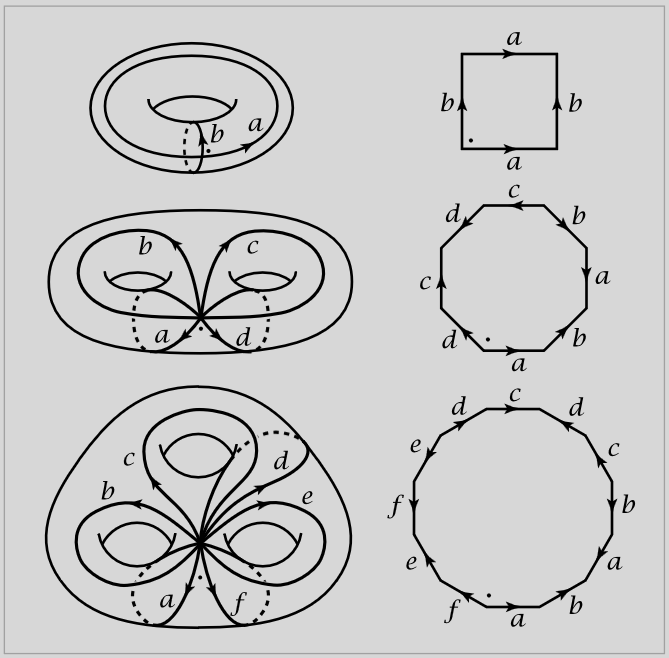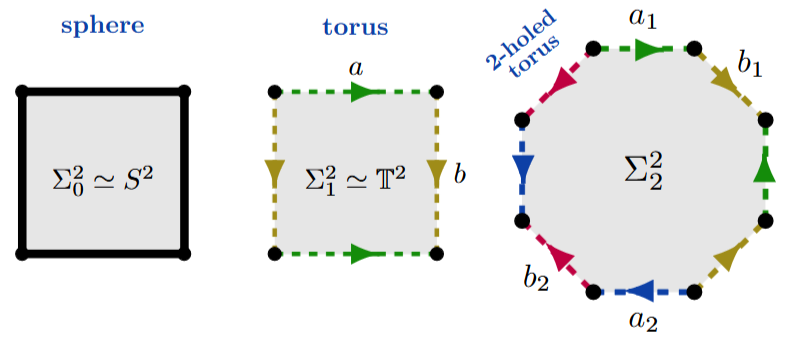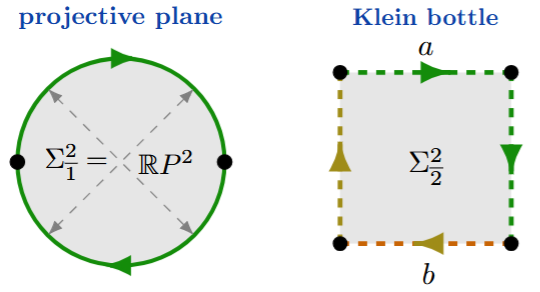nLab surface
Context
Manifolds and cobordisms
manifolds and cobordisms
cobordism theory, Introduction
Definitions
Genera and invariants
Classification
Theorems
Contents
Idea
A surface is a space of dimension 2, usually understood to be connected.
In differential topology/differential geometry this means a 2-dimensional (differentiable/smooth) manifold.
In complex analytic geometry this usually means a complex manifold of complex dimension 2 (hence real dimension 4).
Similarly and more generally, in algebraic geometry an algebraic surface is a variety of algebraic dimension 2.
Properties
Classification
The oriented closed real surfaces are classified, up to isomorphism, by a natural number called the genus (intuitively its “number of holes”, in a sense):
| genus | oriented surface |
|---|---|
| 2-sphere | |
| 2-torus | |
| double torus |
(cf. Kinsey 1991 Thm. 4.14, Gallier & Xu 2013 Thm 6.3, Bray et al. Thm. 4.14)

Here the closed oriented surface of genus may be obtained from the regular -gon by identifying (cf. Giblin 1977 Thm 2.8):
and, going clockwise for ,
-
the st boundary edge with the reverse of the rd,
-
the nd edge with the reverse of the th.

(This and the following graphics are taken from SS25.)
Similarly, the non-orientable closed real surfaces are classified by a positive natural number , also called the (non-orientable) genus or the number of crosscaps
| # crosscaps | non-orientable surface |
|---|---|
| projective plane | |
| Klein bottle |
Here the non-orientable surface with crosscaps may be obtained from the regular -gon by identifying
and, going clockwise for ,
- the st boundary edge with the nd.

(This is a conveniently concise but not the most intuitively visualized choice of fundamental polygons – other choices are possible and often discussed, cf. also MO:q/172784.)
Homotopy
The above classification may be restated in algebro-topological terms by saying that (the homotopy type of) the oriented closed genus surface has a 2-dimensional CW-complex-structure exhibited by the following pointed cell attachment:
Here is the wedge sum of circles, whose fundamental group is the free group on generators , and the attaching map is a representative in this free group of the composition of group commutators
as indicated.
Similarly for (the homotopy type of) the non-orientable surface of crosscap number :
It follows that:
Proposition
The fundamental group of the oriented closed real surface of genus (see above) is the quotient group of the free group on generators by the normal subgroup generated by the group product of the group commutators of the sequence of pairs of generators:
Similarly, the fundamental group of the non-orientable closed real surface with crosscaps is the quotient group of the free group on generators by the normal subgroup generated by the group product of the squares of the sequence of pairs of generators:
(cf. Gallier & Xu 2013 p 100, Actipes 2013 Thm. 6.3).
CoHomology
Proposition
The ordinary homology with integer coefficients of a closed oriented surface of genus is the free abelian group on generators:
By the universal coefficient theorem the analogous result holds for the integral cohomology
It follows for instance that:
Proof
Since spin structures are classified by (see there) this follows by Prop. and the universal coefficient theorem.
Cf. Atiyah 1971, Lawson & Michelson 1989 Ex. 2.6.
Examples
Related concepts
-
punctured surface
-
analog for dimension 1: curve, algebraic curve
References
Monographs:
-
L. Christine Kinsey: Topology of Surfaces, Spinger (1991) [doi:10.1007/978-1-4612-0899-0, pdf]
-
Richard E. Schwartz: Mostly Surfaces, American Mathematical Society, Student Mathematical Library 60 (2011) [draft: pdf, endmatter:pdf]
-
Jean Gallier, Dianna Xu: A Guide to the Classification Theorem for Compact Surfaces, Springer (2013) [doi:10.1007/978-3-642-34364-3, Wikipedia entry]
In the broader context of algebraic topology:
-
P. J. Giblin: Graphs, Surfaces and Homology – An Introduction to Algebraic Topology, Chapman and Hall (1977) [doi:10.1007/978-94-009-5953-8]
-
Allen Hatcher: Algebraic Topology, Cambridge University Press (2002) [ISBN:9780521795401, webpage]
-
Clark Bray, Adrian Butcher, Simon Rubinstein-Salzedo, chapters 2 & 4 of: Algebraic Topology, Springer (2021) [doi:10.1007/978-3-030-70608-1, pdf]
See also:
-
Wikipedia: Surface (topology)
-
Wikipedia: Genus g surface
-
Peter Andrews: The Classification of Surfaces, The American Mathematical Monthly 95 9 (1988) 861-867 [doi:10.2307/2322906, jstor:2322906]
Review and exposition of the classification of surfaces by fundamental polygons:
-
Giblin 1977, chapter 2
-
E. C. Zeeman: An Introduction to Topology – The Classification theorem for Surfaces [pdf, pdf, pdf]
-
Chen Hui George Teo: Classification of Surfaces, REU notes (2011) [pdf, pdf]
-
Thomas George: The Classification of Surfaces with Boundary, REU notes (2001) [pdf, pdf]
-
Eugene Gorsky: Classification of Surfaces, lecture notes (2021) [pdf]
-
Ana da Silva Rodrigues: Classification of Surfaces, BSc thesis, ETH (2023) [pdf, pdf]
-
Neil Strickland, section 11 of: A Bestiary of Topological Objects [pdf, pdf]
See also:
- Wikipedia: Fundamental polygon
Review of the computation of the fundamental group of surfaces:
Discussion of de Rham cohomology of surfaces:
- William Fulton, §18 of: Algebraic Topology – A First Course, Graduate Texts in Mathematics 153, Springer (1995) [doi:10.1007/978-1-4612-4180-5]
Concerning spin structures on compact surfaces:
- Michael Atiyah: Riemann surfaces and spin structures, Annales scientifiques de l’École Normale Supérieure, Serie 4, Volume 4 (1971) no. 1, pp. 47-62 [numdam:ASENS_1971_4_4_1_47_0]
Last revised on August 25, 2025 at 13:20:04. See the history of this page for a list of all contributions to it.